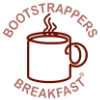Mark Duncan is our guest speaker this Friday in Palo Alto, he will be talking about the sales process for new products from an entrepreneurial perspective. He will also take some volunteers through an exercise in developing a simple customer qualification flowchart. In keeping with the tradition for speakers at Bootstrappers Breakfasts he has a few minutes of prepared thoughts and then he will answer questions and take a few volunteers through the process of developing a potential customer qualification flowchart. It’s a very useful technique that helps you to focus your efforts on prospects that are most likely from your product or service–and therefore best able to close.
Mark and I exchanged several e-mails to compose a short get acquainted interview for those considering attending on Friday.
Q: Can you talk a little bit about your regular work experience
A: I’ve worked in two successful startups, Tandem and Imagen; and founded another startup, Syfx that failed. While I started out as an engineer, I got into marketing over 20 years ago, when I was continually assisting non-technical marketing people with technical products. Truth be known, it is much easier to educate an engineer in marketing, than to teach engineering to a non-technical marketing person.
Q: And that has led you to a mix of consulting and startup activities. Can you share some lessons learned from some of the startups you’ve worked on?
A: When founding a startup, it really helps to have as founders, people that you have worked with before. If you do not have personal work experience with someone that you are trying to recruit, you need to do considerable work to make sure that they are the right fit. It is very much like a marriage, and the wrong person can doom your startup. Three key questions I like to see answered “yes” are
- Do they have a history of doing what they said they would do, on time?
- Are they a self-starter, able to work with minimal, if any, support?
- Are they hungry, willing to put in the long hours and neglect other commitments as needed?
Q: Knowing what you know now, what, if anything would you have done differently or will do differently on your next startup?
A: In helping other startups, I’ve observed that each has its own unique needs. Some are solutions in search of a problem, whereas many others simply have “holes” in some portion of their product / marketing / sales that results in poor sales, and ultimately running out of runway if not correctly in a timely fashion.
Q: Can you talk about your consulting practice?
A: As a consultant, I try to identify the holes, than participate in filling them. This has resulted in everything from positioning, competitive analysis, writing white papers, identifying potential customers ô in essence doing whatever it takes to help them achieve success.
Q: What experiences led you to develop your “potential customer qualification flowchart”
A: The potential customer qualification flowchart evolved from a need to communicate quickly to sales people, both the factors that made for an ideal customer (where you are solving a need) and those factors where they have requirements that you simply are not able to address well (show stoppers). Sometimes startups are like a drowning person, any potential customer is a good prospect. But if you can’t wind up with a happy customer that will provide a good reference, or you are losing your shirt on the deal; it typically is better to focus on other opportunities.
Q: At the breakfast you are going to ask for a volunteer to two and actually take us through how a startup might build one?
A: Depending upon time and interest I hope to have two or three volunteers go through an abbreviated analysis for a simple qualification flowchart. I will have handout available for everyone who comes, but I find if you work through it interactively you obtain much more understanding of how to develop and use one.
